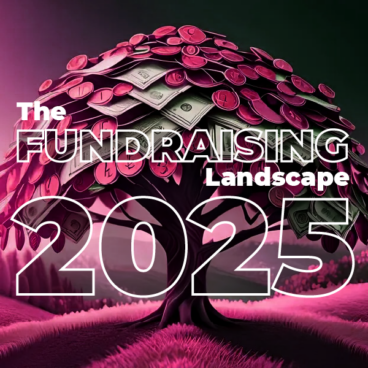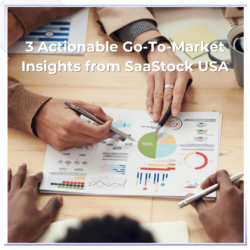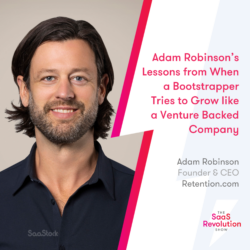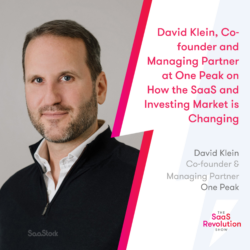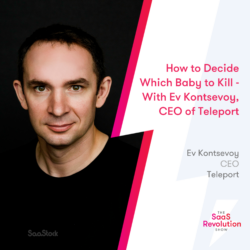2024 VC investment can be summed up in one word: concentration. Of the $370 billion invested by VCs, funding was heavily concentrated across specific geographies (56% in the US), sectors (almost a third in AI) and time periods (30% in Q4), with SaaS growth-stage and enterprise funding also swelling at the expense of early-stage SaaS startups.
With investors expecting ‘double digit growth in VC funding’ this year, how will SaaS VC fundraising shape up in 2025?
In this guide, we’ll discuss what VCs think about the current landscape, what’s changed compared to previous periods, and what SaaS founders need to focus on to meet VC expectations.
2024: A recap of SaaS VC fundraising
In total, global VCs made 35,000+ deals in 2024. When it comes to SaaS’ share of the VC funding pie, there were three major trends.
Growth-stage over early-stage
In 2023, Jean-Laurent Pelissier, MD and Head of Enterprise Software at HSBC Innovation Banking, told the SaaS Revolution Show that fewer deals beyond Series B were taking place. A year later, the reverse was true.
Speaking at SaaStock in 2024, Pelissier explained that growth-stage companies’ sound fundamentals and efficiency “brought capital back into the Series C ecosystem,” with investors actively targeting companies with proven product-market fit.
In H1 2024:
- 65% of European SaaS funding was allocated to Series C+ companies.
- Series A funding was down 34%.
What’s more, GP Bullhound’s 2024 European SaaS report found that median size deals for Series B+ increased dramatically in 2024 and Sapphire Ventures expects Series C+ investment to claim over 40% of SaaS VC funding in 2025.
Larger deal sizes, but less volume (especially in Q4)
2024 was a turbulent year for SaaS VC funding with record-breaking $1 billion+ fundraising rounds, as well as the lowest volume of deals in seven years (35,000 deals).
This concentration was most noticeable in Q4. 2024 witnessed four of the 10 largest ever VC rounds with SaaS data analytics platform, Databricks’ December 2024 Series J topping the list ($10 billion). In fact, Q4 accounted for 30% of all VC funding, but also the lowest deal volume (7,000) in over 10 years.
However, the steady increase in funding throughout 2024 (i.e. European SaaS funding suffered year-on-year falls in Q1 and Q2) is a good indicator of increasing investor confidence as we move into 2025.
AI dominance
If AI was the buzzword for 2023, it was the golden ticket for VC funding in 2024.
PitchBook data found that a third of global VC funding was allocated to AI-related fields last year, rising to 46% of US VC funding. In addition, AI companies accounted for the three largest VC deals in Europe, including a $500 million Series B for AI SaaS Poolside and a $500 million Series E for customer engagement platform Insider.
The huge volume of AI funding squeezed investments in other SaaS markets, contributing to 2024’s low number of overall deals, but in the spirit of SaaS, there were of course some outliers.
For example, in Q4 2024 and Q1 2025:
- Hockeystick raised a $20M Series A.
- Travel management startup TravelPerk raised $200 million.
- Clay, the AI-powered sales startup, raised £40 million (and achieved a $1.3 billion valuation).
VC expectations in 2025
Investors want to invest. Back in 2023’s economic doldrums, Carl Fritjofsson, General Partner at Creandum, told the SaaS Revolution Show that the funding landscape “was not as bad as some people may think it is, especially at the early stages.” For him, 2021 and 2022 were the real anomaly years and investors were still looking to invest in high-growth companies with at least 2x or ideally 3x year-on-year growth for Series A (or 4-5x for really large rounds). The only difference? This growth could no longer come at all costs.
Today, this high bar of growth and efficiency has not been lowered. According to Marton Medveczky, Associate Partner at tech-focused Flashpoint Venture Capital, Flashpoint aims to invest in $1 million ARR companies with a 3x growth rate, which are very capital efficient and do not spend much on attracting customers.
This not only impacts what founders need to attract investment in 2025, but also shifts when companies should apply for each fundraising stage.
SaaS funding stages in 2025
Greater VC expectations have shifted the level of company maturity for each fundraising stage. In 2025, we can expect:
- Seed rounds for companies with at least $0.5-1M ARR.
- Series A for companies usually at $2-6M ARR.
- Series B for companies approaching $10M ARR (rather than $4-5M).
While the due diligence process and expectations from investors adjust as you scale, one thing remains consistent: it’s difficult and deals aren’t done overnight.
Trumpet Co-Founder Nick Telson-Sillett shared how the company secured $1.6M Pre-Seed funding, when Trumpet was four weeks off product completion and had 1500 users on the waitlist. In short, Trumpet:
- Reached out to 154 investors (85% VC, 15% Angel).
- Got 97 first meetings (taking up to 7-9 meetings per day).
- Had 80 second meetings.
- Received 59 responses: 35 Nos, 24 Yes (the rest quiet).
- Spent 12 weeks fundraising from cold outreach to term sheet completion.
What makes a founder investable in 2025?
If you’re looking to raise VC funding for your SaaS company in 2025, the more investable you are, the easier the process.
Speaking on the SaaS Revolution Show at the end of last year, Marton Medveczky explained what he’s looking for in both founders and companies in 2025.
- Strong founder compatibility. The personal chemistry between the VC and the founder is “probably the most important part of venture investment”. In particular, he’s looking for assertive and aggressive founders.
- Companies with a capital efficiency edge. For instance, companies selling to global markets, but with their backend or engineering teams located in countries with lower labour costs, such as Central and Eastern Europe.
- Companies with strong GTM potential. Companies that spend little money to attract new customers, have a large market and garner strong customer feedback (i.e. they value your product for the pain point it solves).
SaaS VC funding metrics
What’s more, you need to show the right metrics for your fundraising stage. Speaking at SaaStock Europe, Kyle Poyar (Growth Unhinged) told us that classic SaaS metrics are less important than product metrics if you’re trying to raise at an early stage.
At Seed, for instance, LTV:CAC is not important as you don’t know what your LTV will look like. Instead, you should look at usage retention and user adoption to show investors that you have consistent customers consistently using the product. In turn, this shows you’re ready to invest in sales and marketing.
Meanwhile, at Flashpoint’s investment ‘sweet spot’ (companies with $1.5-2 million ARR), the key ‘investable metrics’ include:
- Low ICP churn. If you’re selling to mid-market or enterprise customers, Flashpoint does not want to see these customers churn higher than 20% per year.
- Efficient ARR growth. Revenue to the raised amount should be close to one. If you’ve raised $5 million, but only achieved $1 million ARR, you’re not very efficient or investable.
- High net dollar retention (NRR). Flashpoint’s ‘most important’ metric highlights the product quality, sales quality and room for expansion with existing customers. Flashpoint is looking for 120-130% NRR, so you grow 30% next year by doing nothing (median SaaS NRR was 110% last year).
How to balance fast growth and capital efficiency
Take all of the above together and VCs are looking to fund high-growth and capital efficient SaaS companies: a rare combo.
“The combination of high growth and capital efficiency means there’s just much fewer companies that are Venture backable,” says Creandum’s Carl Fritjofsson.
Therefore, in 2025, you can’t rush prospects over the line, discount at all costs, or make promises about product features before checking in with the product team. Growth needs to be more considered and, most importantly, more sustainable.
Here are some steps you can take towards efficient growth:
Targeted acquisition
Of course, acquiring new customers will always be important. But in this market, rather than casting the net wide and seeing what comes in, take care to really understand your ICP, their problems, and where they are looking for solutions.
This way, you can run sales and marketing campaigns that target the right people, on channels where they are already looking for a solution like yours.
Targeting the right type of customer more effectively will help to keep customer acquisition cost (CAC) down. It’ll also mean they’re likely to get value from the product more quickly and stay with you for longer, keeping your CAC to lifetime value (LTV) ratio nice and healthy.
Which brings us on to customer retention…
A focus on retention
Retention-driven growth should be top of mind for SaaS leaders looking to get ahead. Having more consistent recurring revenue and reducing reliance on net new revenue is a solid step towards sustainability.
Focus on increasing average revenue per user (ARPU) by streamlining your customer experience and reducing the time it takes to get value from your product. Of course, this is heavily reliant on having product market fit and understanding your customers but there are operational tactics too:
- Reduce friction in your onboarding flows to get customers up and running quickly.
- Implement cancellation flows and win back campaigns that counter voluntary churn.
- Review payments and billing processes, close any leaks, and reduce involuntary churn.
Strategic upsells
Focus on customer success and look for opportunities to grow with your existing customers. For example:
- Review your product and pricing packages, identify upsell and cross sell opportunities.
- Look at your customer base and target those most likely to convert (e.g. those reaching their package limits each month).
Operational efficiency
Look internally at your business’ operational efficiency. Review where your cash is being spent and find places where you can keep internal costs down.
Here are some places to start:
- Review and consolidate app usage and subscriptions across the company.
- Review what tasks can be automated, freeing your team up to focus on growth.
- Review expense policies and benefits packages.
- Scale back hiring and focus on critical roles that support growth.
Meet your next VC investor at SaaStock
Are you ready to get VC investment?
To get VC funding, you need to meet the right investors and build relationships with them. For the last 10 years, SaaStock events have successfully connected Pre-Seed through Series C start-ups with global VCs and angel investors – be it through dedicated networking opportunities, meetings on the show floor, or via our global pitch competition.
We’ve grown from 800 attendees to hosting 4,500+ of the brightest minds in SaaS and we’re proud to have been the catalyst for:
- Paddle’s $200M acquisition of ProfitWell by Paddle (started with a chance meeting at SaaStock 2017 with Christian Owens and Patrick Campbell).
- Miro landing a €50M Series C (after connecting with ICONIQ Capital at SaaStock 2019).
- Userflow’s $60M acquisition by Beamer (which began at SaaStock 2022).
Fancy joining them in the pantheon of SaaStock success stories?
Get your tickets to SaaStock Europe (14-15 October, Dublin) or SaaStock USA (13-14 May, Austin) in 2025.
